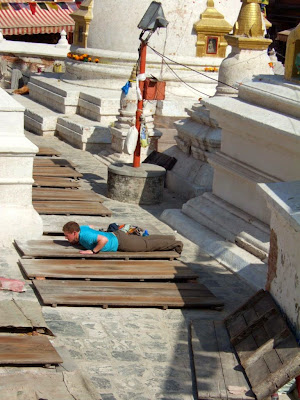
The great stupa of Boudhanath or commonly known as Boudh meaning Lord of Wisdom, lies about 8km east of Kathmandu in a hilly surrounding as if a jewel in the center of natural mandala. The protective, purifying and wish-granting stupa features with two Buddha eyes at 4 sides seated on an octagonal base inset with prayer wheels. The stupa built by Lichchhavi King Kana Dev in 5th century is one of the biggest colossal and ancient stupa in the world.


The splendid dome of Boudhanath stupa measures one hector in width by 43 meters in height with diameter of 36 meters. There are 108 niches enshrined with stone sculptured deities at the terrace beneath the dome. All images were said to be commissioned by Sakya Zangpo in 16th century.




There are many stories concerning about the origin and history of the stupa. Himalayan Buddhists believes that the great stupa was initially built by a widow named Jyazima who was then a poultry keeper. She aspired to make a great offering with her hard earned money to Buddha. Her approach for using an area of land equivalent to a size of a single buffalo skin was granted by the king. The smart lady cut the skin into thin strips and claimed the land enclosed from the strips laid end to end. The mere ambition of Jyazima to build such a magnificent monuments to offer to Buddha caused much jealousy from the rich and powerful lords who petitioned the king to demolish the stupa but the king refused to rescind his permission. Thus the name of Jyarung Khashyor was used for the Stupa.



The Mani Wheels fixed in the surrounding walls are advised to turn in clockwise direction and in the meantime recite The 6-words compassion mantras Om Mani Ba Mi Hung



The local Newar People like to address the great stupa as Khasa or Khastic Chaitya which means The Dewdrop Stupa as they have another version of legend about it. It was said that during 4th century, the nation was hit by severe drought and King Dharmadeva after listening to his astrologers that the most virtuous man in the kingdom must be made as sacrifice to God for rain, decided to be the victim himself. His son, Prince Manadeva obeyed his order to decapitate him with one stroke and put him in a shrouded form but was horrified to see that his head flied out from the body and landed at Vajra Yogini in Sankhu. Prince Manadeva was then told by goddess that in order to undo his sins, set free a cock and the spot where the cock landed, built a stupa to contain his father's body. Construction was carried out during drought period when water was in great shortage. The laborers had to lay out cloth at night to collect the dew in the morning for the mixing of mortar. The Newari name of the Stupa was derived from this story.



A sincere devotee from western country.



Tibetan temples around all corners




Souvenir shops at site.



No comments:
Post a Comment